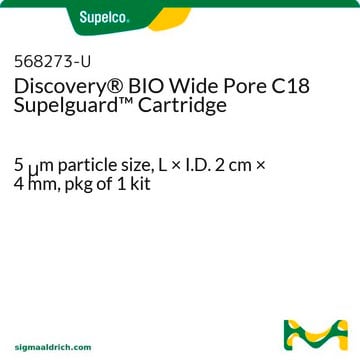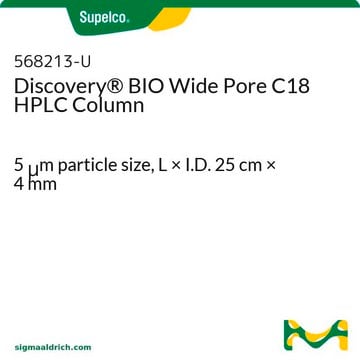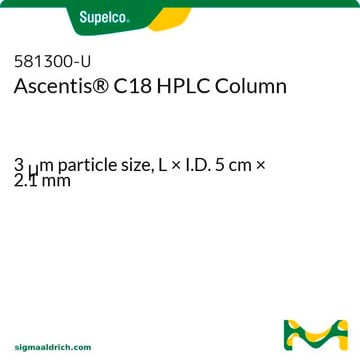Reverse Phase Column Rehydration Method:
1. The column should ideally not contain any buffer. If it does, thoroughly flush the column with water to remove the buffer.
2. Flush the column with 100% acetonitrile, starting at a flow rate of 0.3-0.5 ml/minute. Slowly increase the flow rate to 1 ml/minute, flushing for approximately 30 minutes, as long as the pressure does not excessively increase.
3. Equilibrate the column with the mobile phase specified on the Certificate of Analysis (CofA) of the column, and run a test mix similar to what was used to test the column.
4. If the performance is unsatisfactory, repeat the method, increasing the flushing with acetonitrile for one hour.
5. Repeat the test. If the performance is still not as expected, the column may have degraded.
₩1,648,157
출고 가능일2025년 4월 21일세부사항
추천 제품
제품명
Discovery® BIO Wide Pore C18 HPLC Column, 5 μm particle size, L × I.D. 25 cm × 4.6 mm
material
stainless steel column
Quality Level
Agency
suitable for USP L1
제품 라인
Discovery®
특징
endcapped
제조업체/상표
Discovery®
포장
1 ea of
라벨링 범위
9.2% Carbon loading
파라미터
0-70 °C temperature
400 bar pressure (5801 psi)
기술
HPLC: suitable
LC/MS: suitable
길이 × I.D.
25 cm × 4.6 mm
표면적
100 m2/g
표면 범위
3.6 μmol/m2
Matrix
silica particle platform
fully porous particle
기질 활성군
C18 (octadecyl) phase
입자 크기
5 μm
공극 크기
300 Å
작동 pH
2-8
분리 기술
reversed phase
유사한 제품을 찾으십니까? 방문 제품 비교 안내
일반 설명
애플리케이션
- Kinetic performance comparison of superficially porous, fully porous and monolithic reversed-phase columns by gradient kinetic plots for the separation of protein biopharmaceuticals.: This study provides a detailed kinetic performance comparison of different types of reversed-phase HPLC columns, including the Discovery® BIO Wide Pore C18 HPLC Column. The research highlights its efficiency and resolution in separating complex protein biopharmaceuticals, making it a valuable tool for analytical chemists in biopharmaceutical analysis (Jaag et al., 2022).
- RP-LC x RP-LC analysis of a tryptic digest using a combination of totally porous and partially porous stationary phases.: This paper investigates the use of reverse-phase liquid chromatography (RP-LC) with both totally porous and partially porous stationary phases, including the BIO Wide Pore C18 HPLC Column, to analyze tryptic digests. The findings demonstrate its robustness and high resolution in proteomics applications, enabling precise peptide mapping and protein characterization (Mondello et al., 2010).
법적 정보
이미 열람한 고객
관련 콘텐츠
DiscoveryBIO Wide Pore C18 products offered by Sigma-Aldrich.
Chromatograms
application for HPLC-
What is the method for rewetting a column that may have dried as a result of the end cap being loose or not being used for an extended period of time?
1 답변-
도움이 되었습니까?
-
-
WHIGH SOLVENT USED FOR WASHING OF COLUMN
1 답변-
See below for a general cleaning protocol:
1. Reverse the orientation of the column
2. Flush for a few minutes, or >1 column volume, with a 20% solution in water, of the organic used in the analysis, such as methanol or acetonitrile. This is to remove any residual buffer salts.
3. Flush for approximately 30 mins, or >10 column volumes, with 100% of the organic solvent used in the analysis.
4. The column can be stored with this organic solvent until ready for use.
5. Before reusing the column, flush again, as per step 2.도움이 되었습니까?
-
활성 필터
자사의 과학자팀은 생명 과학, 재료 과학, 화학 합성, 크로마토그래피, 분석 및 기타 많은 영역을 포함한 모든 과학 분야에 경험이 있습니다..
고객지원팀으로 연락바랍니다.










